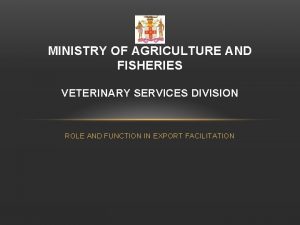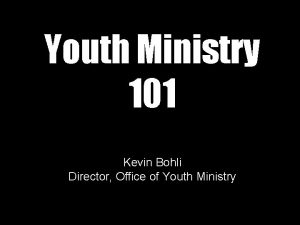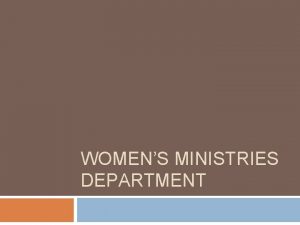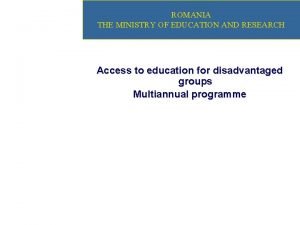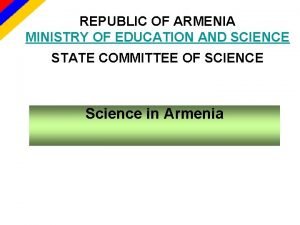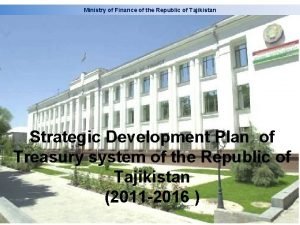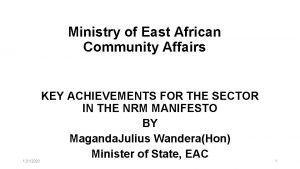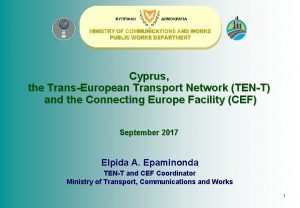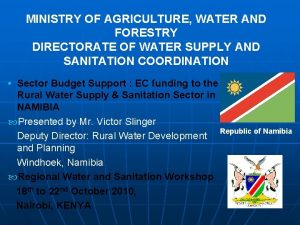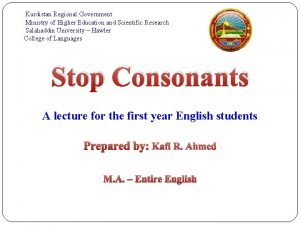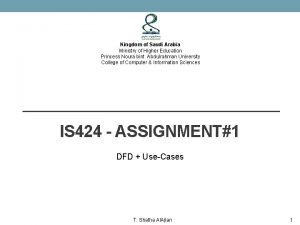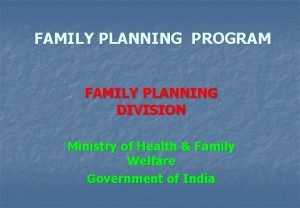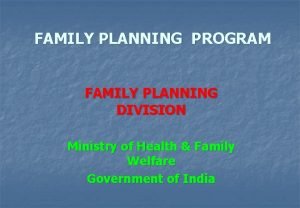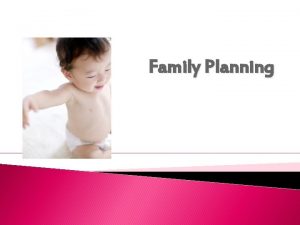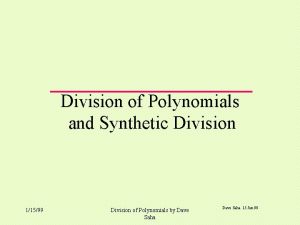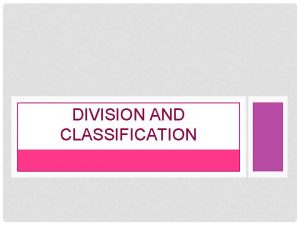FAMILY PLANNING PROGRAM FAMILY PLANNING DIVISION Ministry of







































- Slides: 39

FAMILY PLANNING PROGRAM FAMILY PLANNING DIVISION Ministry of Health & Family Welfare Government of India

2

DEMOGRAPHIC SCENARIO 1. India is the second most populous country in the world. 2. India has 17 % of world’s population and has less than 3% of earth’s land area. 3. While the global population has increased 3 times, India has increased its population 5 times during the last century. 4. India’s population is expected to exceed that of China before 2030 to become the most populous country in the world. 3

4

5

WHAT IS TFR n n n The total fertility rate is the average number of children a woman would have if she were to pass through her reproductive years bearing children at the same rates as the women now in each age group. It is computed by summing the age specific fertility rates for all ages. It gives a magnitude of completed family size In simple terms TFR denotes the average number of children borne per woman 6

7

Benefits of family planning n. Stabilises population n. Reduces maternal n Reduces mortality infant and child 8

Slower rates of population growth benefit all aspects of development Health Education Agriculture Population Economy Environment Urbanisation 9

National Population Policy, 2000 v IMMEDIATE OBJECTIVE Address the unmet needs of contraception, Reproductive and Child Health care v MEDIUM TERM OBJECTIVE Achieve Replacement Level Fertility by 2010 v LONG TERM OBJECTIVE Bring about population stabilisation by 2045 10

Situation analysis NPP 2000 and the present scenario: 1. 2. 3. 2010 Population replacement (put back now to 2021) 2045 Population Stabilization (put back now to 2060 (1. 53 billion in 2060). EAG states constitute 42% of the population (TFR between 3. 4 and 4. 3) 11

GOI POLICY (Servicing the unmet need) n Based on felt needs of the community TARGET FREE n Children by choice & not chance n n n Equal emphasis on both limiting and spacing methods ELA : Scientific and statistically significant way being formulated for calculating state wise performance level based on unmet need Population stabilization is a priority area of the GOI 12

MEETING UNMET NEEDS 1 Two third Indians want to use contraception 2 There is no scope for coercion 3 Ensure availability of quality RH services 4 Meet the felt needs of couple 5 Enable couple to achieve their RH goals v 13

Programatic interventions in Family Planning (GOI) 1. Addressing the unmet need in contraception through n n 2. 3. 4. 5. Assured delivery of family planning services Developing skilled manpower for the same Increasing male participation through intensive promotion of NSV Promotion of IUDs as a short & long term spacing method Promotion of Emergency Contraceptive Pills Increasing basket of choices 14

Promotional Interventions in Family Planning (GOI) 1. 2. 3. 4. 5. Ensuring quality care in FP services Revised compensation scheme Family planning insurance scheme Promoting Public Private Partnerships Promoting contraception through increased advocacy 15

Temporary (Spacing) Methods n IUD 380 A n EC Pills n OC Pills n CC ( dual purpose condoms) 16

Reduce unmet need in Spacing (advantages of IUD 380 A) 10 years’ duration & not 3 years n Can cover reproductive life span in 2 insertions only (25 - 45 yrs. ) n Can potentially replace the sterilization procedures n Can be inserted at subcentre level n ANM/ MOs could be given refresher training n 17

Promotion of EC Pills n n n 2 tabs of 0. 75 mg or 1 tab of 1. 5 mg within 72 hrs of intercourse in the following situations: n Unprotected intercourse n Unplanned intercourse n Failed CC (Nirodh- torn) n Assault/ rape Levonorgesterol only No side effect One time activity to replace MTP Reduces Maternal Mortality by 10 -15% 18

Reducing unmet need in Terminal method n Assuring service provision through n Fixed day service round the year n Periodic camps n Augmenting trained manpower in n NSV n Minilap n Lap. Ster. 19

Male participation (Why No Scalpel Vasectomy- NSV ? ) 1. 2. Attain population stabilization in a short period Shifting responsibility of family planning from females to males 20

Why NSV ? 6 Ss: - (advantages) n Scalpel less n Stitch less n Safe n Sound n Simple n Short 21

Tubectomy (If client chooses it after all options have been explained) n Offer minilap because n No postgraduate surgeon/ gynaecologist required n No anesthetist required normally n No pneumoperitoneum (inflating with gas) n Less post operative distress n If client still demands Laparoscopic Tubectomy Offer services routinely at DH, FRU, CHC, BLOCK PHC (wherever OT is available) 22

Camps in tubectomy n n n Should preferably start by 9 AM As the client is fasting since the previous evening Has travelled long distances to reach the camp site and Is dehydrated Has to have 4 hrs post operative observation before being discharged after being rehydrated 23

Ensuring quality care in FP n n n The manual on Standards in sterilization has been updated, printed & uploaded on the website. The manual on Quality assurance in sterilization has been updated, printed & uploaded on the website. Six Regional Dissemination Workshops on the revised Standards and QA manuals held countrywide in 06 -07. 24

Ensuring quality care in FP n n n All states reported to have set up the QACs at state and district levels as per affidavit filed by them in the supreme court Revised extended QAC as per the updated manuals are in place in most of the states. Most states have completed their orientation of the districts for QA 25

COMPENSATION A. For Public (Govt. ) facilities Breakage of the Compensati on package Acce ptor High focus states VAS. (ALL) 1100 200 TUB. (ALL) 600 Non High focus states VAS. (ALL) Non High focus states Motivat Drugs or and dressin g 150 1100 200 Surgeo n charges Anest hetist Staff nurse OT techni cian/h elper Refresh ment Camp managem ent Total 50 100 - 15 15 10 10 1500 100 75 25 15 15 10 10 1000 50 100 -- 15 15 10 10 1500 TUB (BPL + SC/ST only)) 600 150 100 75 25 15 15 10 10 TUB (APL) 250 100 75 25 15 15 10 10 1000 650 26

COMPENSATION B For Private Facilities: Category High focus states Type of operation Vasectomy (ALL) Tubectomy (ALL) Non. High Vasectomy focus (ALL) states Tubectomy (BPL + SC/ST) Facility Motivator Total 1300 1350 200 150 1500 27

Family Planning Insurance Scheme (limit of indemnity) Claims arising out of Sterilization Operation Amount A Death at hospital/ within seven days of discharge Rs. 2, 000/- B Death due to sterilization (8 th – 30 th day from the date of discharge ) Rs. 50, 000/- C Expenses for treatment of Medical Complications Rs. 25, 000/- D Failure of Sterilization Rs. 30, 000/- E Doctors/ Facilities covered for litigations up to 4 cases per year including defence cost Rs. 2, 000/- n n Dissemination meetings conducted for all state officials Public institutions to display boards on the scheme _____________ 28

9. Strengthening contraceptive supply n n n NSV instruments n Revised Specifications prepared in 2006 (on website) • States asked to procure as per their requirements through PIP Laparoscopes n Revised Specifications prepared in 2006 (on website) n States asked to procure as per their requirements from central funds as per approved specifications (can place indents with the TNMSC ) ECP supply n Procurement has restarted recently n Requirements from states received and being supplied 29

10. Promotion of contraception through intensive advocacy Advocacy kit on contraceptives n Expert committee and core committee set up n n All existing material reviewed and updated New materials developed for NSV, IUD 380 A, ECP, OCP All prototypes for n audio, n video and n print (leaflets, flip charts, posters) finalised and passed on to the IEC division for production and distribution to the states (Jan, 08) Dissemination of FP capsule through regional workshops (WHO biennium 08 -09) n n Approval obtained Funding awaited 30

Family Planning Components (What the SFT should look for) n Contraception n Conception (infertility management) n Quality Assurance n Accreditation of facilities n Empanelment of providers n Compensation n Insurance 31

Responsibilities of the states/ districts n Increase number of services centres n Availability of services n Accessibility of services n Affordability of services (Upgradaiton of DHs, FRUs, CHCs, PHCs & SCs under NRHM) n Accreditation of private providers (PPP) 32

Responsibilities of the states/ districts Regular fixed day services round the year a) DH b) FRU/CHC c) PHC d) SC - on demand (daily/ weekly) - weekly/fortnightly/monthly - monthly/ bimonthly - (Tubectomy only if OT available) - IUD/ ECP (on demand) Tubectomy: Vasectomy: Wednesday (optional) Saturday (optional) 33

Responsibilities of the states/ districts 1. Ensure at least n One NSV n One Tubectomy n One IUD Surgeon per PHC Provider per SC (ultimate aim) 2. Effect Manpower Rationalization n Manpower Planning (based on ELA) n Manpower Training n Manpower Placement 3. Develop Comprehensive Training Plan for n NSV n Minilap n LTT n IUD n ECP 34

Action at State/Dist. level n Appoint Nodal officer for Family Planning (for Planning, Implementing, Monitoring, Supervising & Evaluation) n n n Constitute QAC at state level (10 members) & notify Constitute DQAC at dist. level (9 members) & notify Accredit facilities (Public/Private/NGO) Empanel doctors (Public/Private/NGO) Conduct n n Half yearly meetings of state QAC (to be minuted) Quarterly meetings of Dist. QAC (to be minuted) 35

Action at State/Dist. level Orientation of CMOs on n n n NFPIS (National Family Planning Insurance Scheme) Compensation Scheme (Revised) ELA district wise for limiting & spacing methods (based on dist. Unmet Need) Manpower development (district action plan) n NSV (MOs) n Minilap/ LTT (MOs) n IUD (MOs/ SNs/ LHVs/ ANMs) n ECPs (MOs/ SNs/ LHVs/ ANMs/ ASHAs) Contraceptive updates District budget allocation and disbursement Monthly Review of FP performance with CMOs 36

Action at State/Dist. level Display prominently (facility wise) Revised compensation scheme n Family planning insurance scheme n Service availability (district action plan) n Fixed day service calendar n NSV n Minilap/ LTT n IUD n Camp calendar for above n IEC materials on n NSV n IUD n ECPs Budget may be provided accordingly n n 37

Action at State/Dist. level Lay down benchmarks (performance indicators) and Rank Districts n Reward districts n Reward CMOs (state award) n Recommend for national recognition n 38

39
 Veterinary services division
Veterinary services division Ministry of education secondary engagement program
Ministry of education secondary engagement program Ministry estate planning
Ministry estate planning Ministry of national development planning indonesia
Ministry of national development planning indonesia 369 times 2
369 times 2 What is the missing number in the synthetic-division array
What is the missing number in the synthetic-division array Long division terminology
Long division terminology Division sintetica
Division sintetica Long division family
Long division family Youth ministry 101
Youth ministry 101 Women's ministry goals and objectives
Women's ministry goals and objectives Women's ministry goals and objectives
Women's ministry goals and objectives Personal ministry plan
Personal ministry plan What is spiritual discernment
What is spiritual discernment Threshold ministry
Threshold ministry Ministry of education serbia
Ministry of education serbia Kuwait ministry of education
Kuwait ministry of education Matriculation certificate
Matriculation certificate Ministry of education romania
Ministry of education romania Ministry of education armenia
Ministry of education armenia Jeremiah timeline
Jeremiah timeline Statoil
Statoil Local guide program
Local guide program Ministry of higher education afghanistan
Ministry of higher education afghanistan Ministry of finance of the republic of tajikistan
Ministry of finance of the republic of tajikistan التعليم الخاص مبارك الكبير
التعليم الخاص مبارك الكبير Ministry of east african community affairs uganda
Ministry of east african community affairs uganda Ministry of transport, communications and works
Ministry of transport, communications and works Ministry of agriculture, water and forestry directorates
Ministry of agriculture, water and forestry directorates Kalakbay youth ministry
Kalakbay youth ministry Ministry of education krg
Ministry of education krg Krg ministry of higher education
Krg ministry of higher education Kurdistan higher education
Kurdistan higher education Ministry of higher education saudi arabia
Ministry of higher education saudi arabia Global ministry center church of the nazarene
Global ministry center church of the nazarene Deeper life bible church netherlands
Deeper life bible church netherlands Seattle university school of theology and ministry
Seattle university school of theology and ministry Angola
Angola Altar ministry training
Altar ministry training Background adventist youth
Background adventist youth
